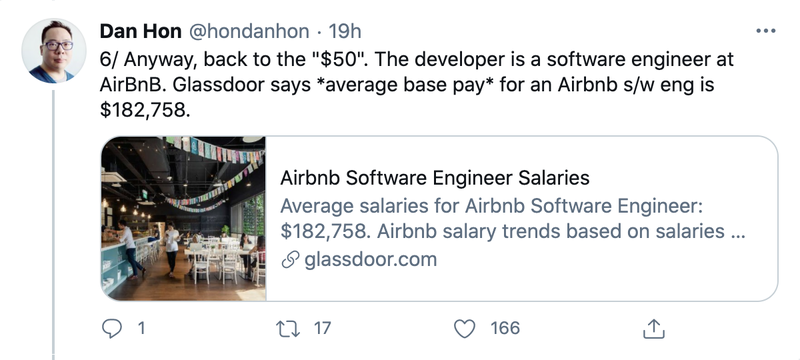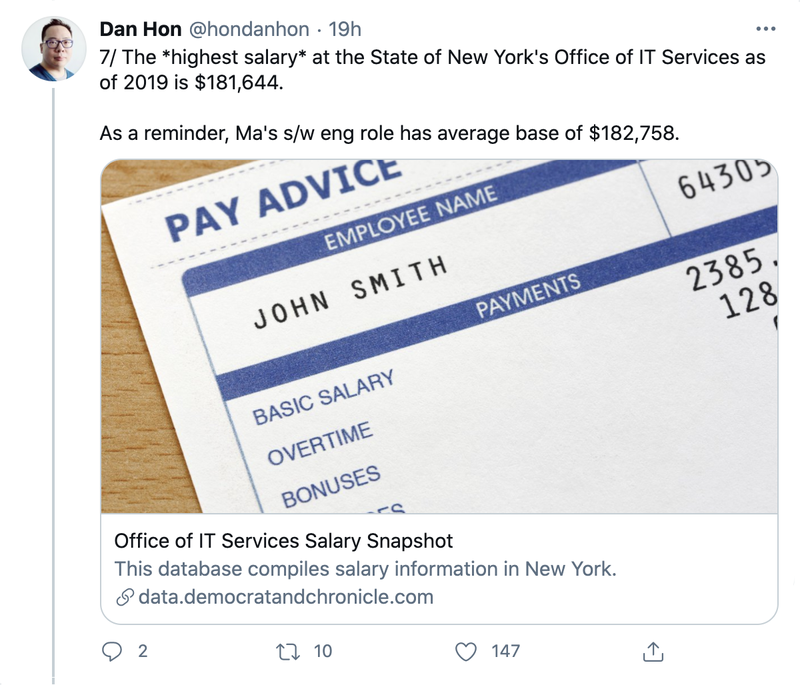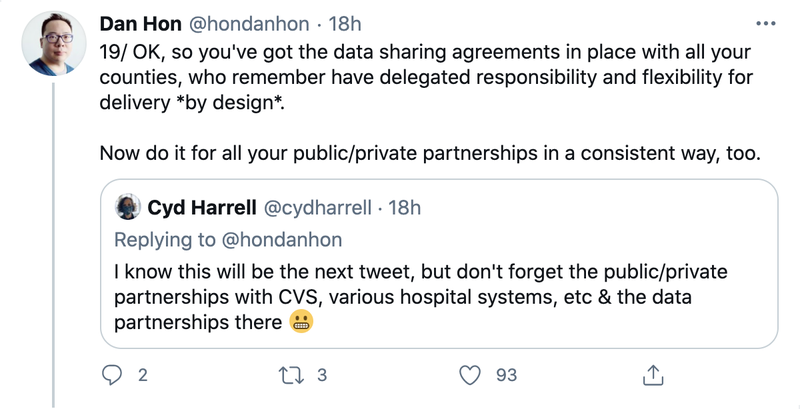The $50 Vaccine Website We Don't Need
Blog Post

Feb. 10, 2021
Recent volunteer technology efforts to shore up deficiencies in the COVID-19 vaccine delivery are an opportunity to understand the complicated environments of social services and healthcare delivery in the United States. When reporting focuses on how quick, targeted volunteer efforts produce (sorely needed) improvements, they do a disservice by not highlighting the differences in how volunteers can work, compared to delivering services against complicated local, state and federal relationships and requirements.
Stereotypical heroine or hero stories run the risk of false and unreasonable expectations for the true cost of equitable government that meets the social contract, trivializing or ignoring hard requirements and difficult problems with no perfect answers. It was with this in mind that I created a tweet thread that has taken off since I posted it. Below, read my thread as it was written along with responses from industry leaders and pundits. Also, I want to add that I wrote this because I respect the New York Times as a leader in journalism. I was disappointed that they would write something that is quite frankly pushing a narrative that's not only wrong but dangerous. Getting the vaccine out to as many people as possible is crucial. We don't have time to wait for volunteers. Our government needs to step up and do what's necessary no matter the cost. Lives -- and the ability to live them without masks and fear -- are at state.
I see we're talking about volunteer vaccination websites again, thanks to this (imho) irresponsible NYT article about "building a new [vaccination website] for $50." Some observations and references:
The headline is grossly irresponsible. It says the website "cost" $50, which likely means domain registration and hosting. But Ma developed the site "in less than two weeks", so the headline values Ma's time and effort at... $0.
Workers like Ma earn more than $0.
Off the top of my head, someone with Ma's skill and experience might get charged out to government at $180+/hour. So we're probably at $14,000+ just for billing by time. And yes, government IT frequently costs much more than it should for what's delivered.
By implying that a "better" vaccine website can be delivered for $50, the NYT is contributing to the false belief that government services don't have to be funded to be delivered well, and to unrealistic expectation about how much good government costs.

And like Spike says, the 2 weeks development time (valued at $0), also doesn't include ongoing support and maintenance. But sure, the website "only costs" $50.
The website is, "...currently just some code running on some guy's laptop—anything as much as a wifi outage could knock it out." (https://turbovax.info/about). It "only cost" $50.
Anyway, back to the "$50". The developer is a software engineer at AirBnB. Glassdoor says *average base pay* for an Airbnb software engineer is $182,758.

The *highest salary* at the State of New York's Office of IT Services as of 2019 is $181,644. As a reminder, Ma's software engineer role has average base of $182,758.

If you're going to go join an organization like @USDS or @18F, you'll be subject to the federal government's GS pay scale, which tops out at $170,800 in Washington, D.C. That's $81.84/hr.
- *doesn't book appointments*
- appears to scrape 3 "portals" - two NYC sites and one NY State website.
- and again, explicitly states that its reliability is, at best, "unclear"
Here's what else you get for a "$50" vaccine website: A disclaimer of liability (full text in image alt).

For the avoidance of doubt, Government services don't get to provide disclaimers. That's part of why they cost more than $50. And websites are only *one part* of an end-to-end *service* that delivers an outcome or meets a user need.
Now, you might think I'm shitting on the developer of the vaccine website. I am not! There are significant, horrible problems with the local, last-mile of the vaccine process in the US. This site arguably *does* improve part of the experience.
But...
Do you want to know some of the structural reasons *why* TurboVax exists? Regulations and delivery of care & social services in the US is byzantine *by design.* With the goal of federal -> state -> county flexibility and delivery, it also ends up with the worst of both worlds. Combining the ideal of localized freedom and flexibility to deliver services with the need for high-level standardization and centralization is *difficult and complicated.* And also *underfunded from data & tech infrastructure.*
This isn't just a technology problem (remember: you need to build the technology infrastructure to support this because in most cases *it doesn't exist* and you can't afford to hire Ma), but also fundamentally a *policy (thus political) and operations problem*.
- New York: Has 62 counties and 5 NYC boroughs
- NYC has a GDP of $885 billion and a pop. of 8.3 million
- California has 58 counties.
- LA County has a GDP of $727 billion and a pop. of 9.8 million. Now you're a product manager with the legal responsibility to manage those stakeholders.
Now assume you don't have the data sharing agreements in place to formally, *legally* get the data you need from each of those counties for vaccine delivery. Assume the data infrastructure doesn't exist either. Or the standards. Getting all of that in place is a big management job! But look, I'm sure product managers and directors at e.g. tech companies relish negotiating the politics of 50+ stakeholders.
For $50.
OK, so you've got the data sharing agreements in place with all your counties, who remember have delegated responsibility and flexibility for delivery *by design.* Now do it for all your public/private partnerships in a consistent way, too.

So we're 20 tweets in and as a reminder, the purported newspaper of record for the United States is implying, in its headline, that "vaccine websites" should cost in the order of magnitude of $50. I say this with experience that there are *so many things* that must be improved in how government (local, state, federal) uses technology to meet its promises to the people, like procurement, out of date standards, and overly focusing on following procedure vs outcome. But, and I cannot stress this enough, this idea of a lone tech hero or band of residents/citizens who will deliver radically better government services for trivial amounts of money is *toxic and harmful.* We'll never get the government services we deserve by relying on them.
This stuff is *hard* and in some cases it is absolutely unnecessarily hard and counter-productive, but because it is hard, it isn't going to be *cheap* because doing it well takes time, effort, skill and experience. I am *incredibly disappointed* (I grew up in the UK, so read that as "spitting with rage") at the irresponsible lack of context in the NYT's article and its sensationalist, misleading headline.
I last wrote about the complexity of last-mile vaccine delivery and the technology needed for it in this thread:

Here's a consolidated link to that thread on the complexity of last-mile vaccine delivery technology.
New America Public Interest Technology director of strategy Hana Schank has been doing brilliant work on this and has a great article in Fast Company about vaccine appointment scheduling. Hana is also quoted in this MIT Tech Review article on vaccine distribution by Cat Ferguson and Karen Hao.
Anyway, @nytimes, you should publish a counter to your irresponsible cheap, better vaccine website piece and I don't mean just in the @nytopinion section. One last thing. You know *how* Airbnb and Uber and all those celebrated tech companies grew and delivered innovative services people love? By *deliberately ignoring laws and regulations.* Here's Wikipedia entry on Airbnb's regulatory violations.
Should vaccine websites cost $44 million -- what the CDC bought from Deloitte, and is "plagued by problems and abandoned by most states"? Maybe! Probably! Because they're in really complicated environments. *They should also work and do what they need to do!* Here is another article on volunteer vaccine websites and tools, this one from MIT's Tech Review from 1 February. It is much more responsible and acknowledges the complexity of the problem and environment.
Another point on why the NYT's "$50" headline is irresponsible and harmful. COVID-19 is exposing new groups of people to massive deficiencies in government services in general. These deficiencies include underfunding *as well as* bad/outdated/ineffective policy. For example, @ny_covid is translating their site into 30+ languages. The point here is *government services should be accessible to the people who need to use them in general*. How many services are localized into 30+ languages at the best of times But the NY Times story is celebrating that these sorts of deficiencies can be solved by volunteers for trivial amounts of money, discounting time and effort and complexity, *instead of showing that they point to systemic deficiencies in government*.

End

I'm gonna go have lunch.
Dan Hon is an expert on technology and its role in society. Most recently, he has been doing groundbreaking work transforming government and digital services. He is a keynote speaker on government digital services and the role of technology in society, and you can find his writing in the MIT Technology Review and Wired Magazine.